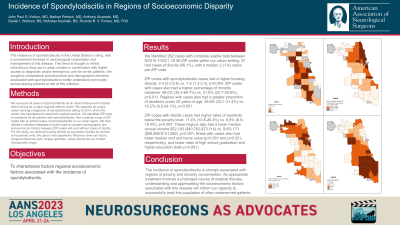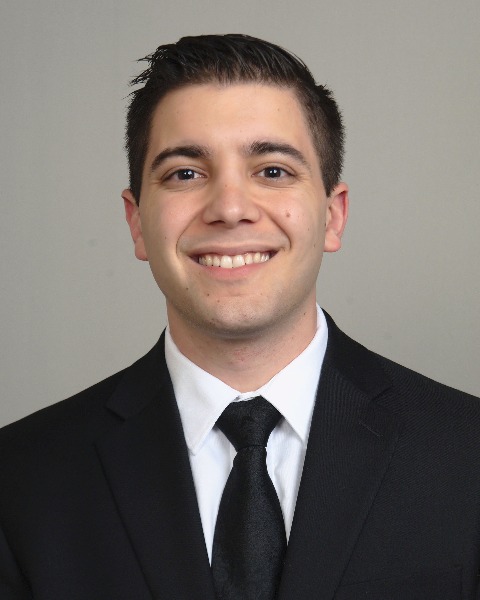Incidence of Spondylodiscitis in Regions of Socioeconomic Disparity
Friday, April 21, 2023


John Paul G. Kolcun, MD
Resident Physician
Rush University Medical Center
ePoster Presenter(s)
Introduction: The incidence of spondylodiscitis in the United States is rising. We sought to characterize socioeconomic and demographic elements associated with spondylodiscitis to better understand community factors placing patients at risk of this infection.
Methods: We surveyed all cases of spondylodiscitis at an urban tertiary-level hospital. We identified ZIP code of residence for all patients. We then utilized a validated database of public data to compare demographic and socioeconomic factors between ZIP codes with and without cases of discitis. We used a non-parametric Wilcoxon rank-sum test to compare these two sets. Values are shown as median (interquartile range).
Results: We identified 262 cases with complete usable data between 9/2015-7/2021. Of 56 ZIP codes within our urban setting, 37 had cases of discitis (66.1%), with a median 2 (1-4) cases per ZIP code.
ZIP codes with spondylodiscitis cases had a higher housing density: 2.4 (2.0-2.6) vs. 1.8 (1.3-2.3), p=0.004. ZIP codes with cases also had a higher percentage of minority residents: 59.0% (34.2-84.7%) vs. 31.9% (22.7-39.8%), p=0.011. Regions with cases also had a greater proportion of residents under 20 years of age: 26.8% (22.1-31.4%) vs. 16.2% (9.2-24.1%), p=0.001.
ZIP codes with discitis cases had higher rates of residents below the poverty level: 17.4% (10.8-26.4%) vs. 8.8% (6.9-18.4%), p=0.007. These regions also had a lower median annual income $52,193 ($40,762-$73,114) vs. $103,173 ($58,558-$121,982), p< 0.001. Areas with cases also had lower median rent and home value (p < 0.001 and p=0.021, respectively), and lower rates of high school graduation and higher education (both p< 0.001).
Conclusion : The incidence of spondylodiscitis is strongly associated with regions of poverty and minority concentration. As appropriate treatment involves a prolonged course of medical therapy, understanding and appreciating the socioeconomic factors associated with this disease will inform our capacity to successfully treat this population of often underserved patients.
Methods: We surveyed all cases of spondylodiscitis at an urban tertiary-level hospital. We identified ZIP code of residence for all patients. We then utilized a validated database of public data to compare demographic and socioeconomic factors between ZIP codes with and without cases of discitis. We used a non-parametric Wilcoxon rank-sum test to compare these two sets. Values are shown as median (interquartile range).
Results: We identified 262 cases with complete usable data between 9/2015-7/2021. Of 56 ZIP codes within our urban setting, 37 had cases of discitis (66.1%), with a median 2 (1-4) cases per ZIP code.
ZIP codes with spondylodiscitis cases had a higher housing density: 2.4 (2.0-2.6) vs. 1.8 (1.3-2.3), p=0.004. ZIP codes with cases also had a higher percentage of minority residents: 59.0% (34.2-84.7%) vs. 31.9% (22.7-39.8%), p=0.011. Regions with cases also had a greater proportion of residents under 20 years of age: 26.8% (22.1-31.4%) vs. 16.2% (9.2-24.1%), p=0.001.
ZIP codes with discitis cases had higher rates of residents below the poverty level: 17.4% (10.8-26.4%) vs. 8.8% (6.9-18.4%), p=0.007. These regions also had a lower median annual income $52,193 ($40,762-$73,114) vs. $103,173 ($58,558-$121,982), p< 0.001. Areas with cases also had lower median rent and home value (p < 0.001 and p=0.021, respectively), and lower rates of high school graduation and higher education (both p< 0.001).
Conclusion : The incidence of spondylodiscitis is strongly associated with regions of poverty and minority concentration. As appropriate treatment involves a prolonged course of medical therapy, understanding and appreciating the socioeconomic factors associated with this disease will inform our capacity to successfully treat this population of often underserved patients.
